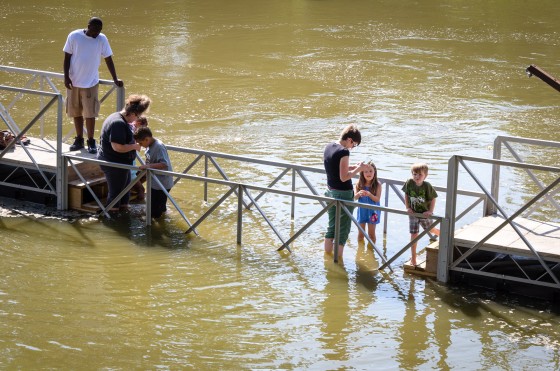The temporary public art installation ‘Wading Bridge’ by New York-based artist Mary Mattingly will not be reinstalled in the Raccoon River in Water Works Park.
The temporary public art installation, a dock off the riverbank that was partially submerged so people could walk in the water, had to be pulled to land last week in response to the flood-stage water levels caused by significant rainfall in the Raccoon River watershed. Organizers had planned to keep ‘Wading Bridge’ in the water through Sunday, August 9, but opted not to reinstall it out of respect for the time of the volunteer installation crew.
“We certainly learned a lot about the river, which was the artist’s key objective,” said Jessica Rowe, director of the Greater Des Moines Public Art Foundation. “I am most excited that this public art project nurtured wider strategies for residents and visitors to explore their relationship with this important natural resource. ‘Wading Bridge’ opened a lot of people’s eyes and illustrated just how much rain runs straight into the river, like a gutter, because we’ve redesigned the land around it to not hold and absorb rainwater. This initiative emphasized that the river’s volatility will be a challenge as we try to reconnect with our river town roots.”
The public art installation was aimed at engaging the community in a conversation about the future of the waterways and nearby greenways in Greater Des Moines. The public is being asked for ideas for approximately 150 miles of the region’s waterways as part of a regional water trails master plan being developed by the Des Moines Area Metropolitan Planning Organization.
The Des Moines Area MPO, the Greater Des Moines Public Art Foundation, Des Moines Water Works Park Foundation, National Endowment for the Arts and the Iowa Arts Council, a division of the Iowa Department of Cultural Affairs, funded the public art project. The art installation river was made possible by the generous volunteer work of Michael LaValle, president of Port of Des Moines, LLC, and Tim Monson of Shuck-Britson.
The public can share their ideas for improving the region’s waterways in an interactive online game. Additional details about the regional waterways planning process.

